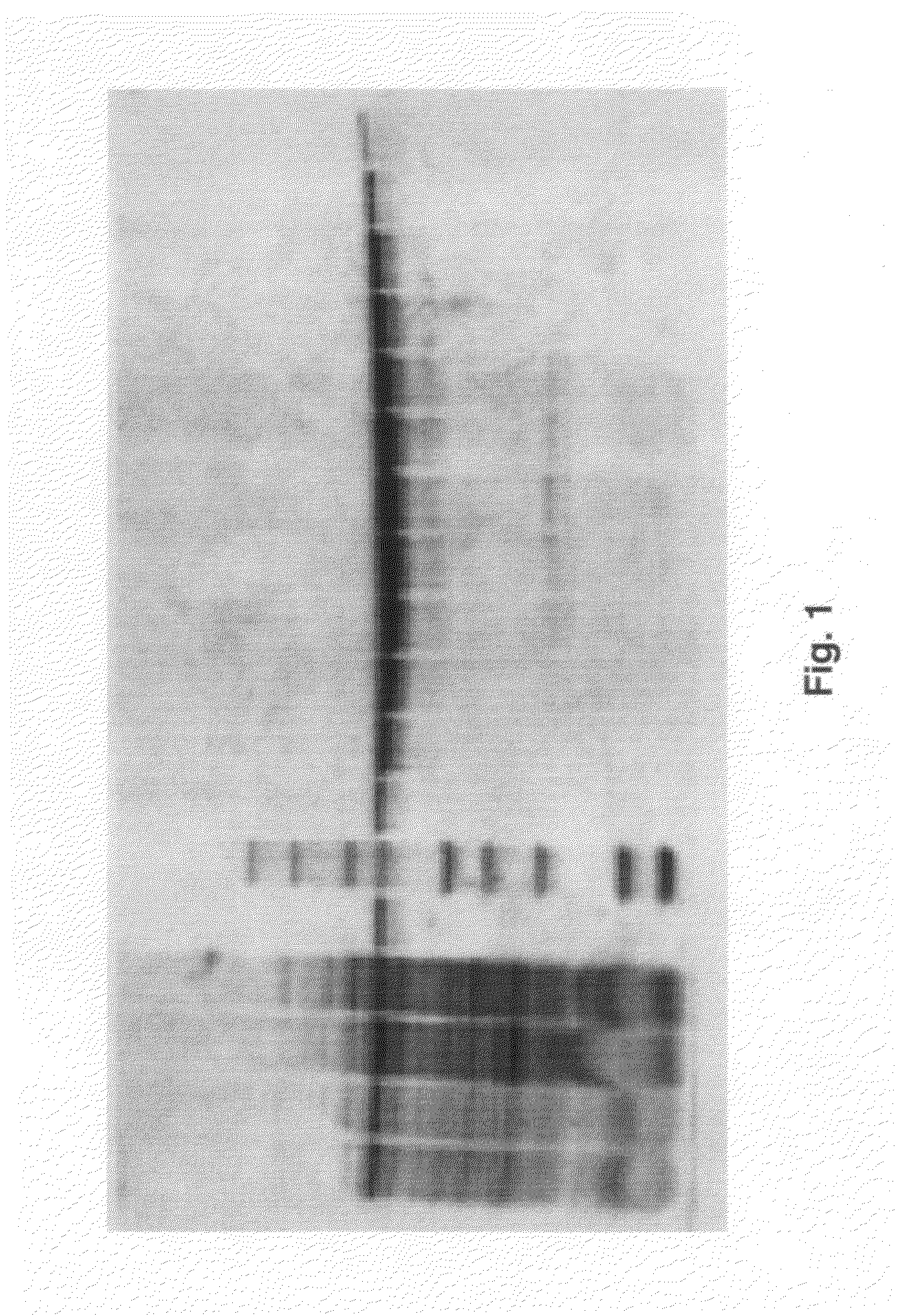Inhibitors of mycobacterium tuberculosis malate synthase, methods of making and uses thereof
a technology of mycobacterium tuberculosis and synthase, which is applied in the field of anti-tuberculosis malate synthase, can solve the problems of asymptomatic latent infection, patient non-repair, and the ability of bacteria to survive for extended periods of time in the body in a non-replicative manner, and achieve the effect of increasing the stability of an aromatic or heteroaromatic diketo acid compound
- Summary
- Abstract
- Description
- Claims
- Application Information
AI Technical Summary
Benefits of technology
Problems solved by technology
Method used
Image
Examples
example 1
Materials and Methods
Malate Synthase Crystal Structure
[0072]Recombinant full-length malate synthase (or GlcB) enzyme is expressed and purified as previously disclosed (1). The structure of malate synthase complexed to the substrate glyoxylate at 2.1 Å resolution and the structure with malate and CoA at 2.7 Å resolution have been described (1). The structure is a TIM barrel fold for the active site-containing domain and a second _-rich domain of unknown function. Unlike ICL, which has an active site on the surface of the protein, malate synthase has a relatively deep and narrow active site (FIG. 2) that extends about 20 Å from the surface of the protein to the bound Mg+2 in the bottom of the active site (shown as a blue sphere). This long deep channel binds atoms of the other substrate, CoA.
[0073]A co-crystal structure of malate synthase complexed with 4-phenyl-2,4-diketobutanoic acid has also been completed. The inhibitor identified through an initial focused screen has an IC50 of 4...
example 2
Phenyl Keto Butanoic Acid (PKBA) Inhibits GlcB
[0089]A high resolution (1.8 Å) crystal structure of wild-type GlcB:PKBA (FIG. 5) demonstrated bidentate binding of the ketoacid moiety to the active-site Mg+2, hydrogen-bonding of the ketoacid ketone oxygen and the aryl ketone oxygen to Arg-339, and hydrophobic interactions of the phenyl substituent with Leu-461, Met-515, Thr-517, Cys-619, and Met-631. Thus, PKBA derivatives and analogs optimizing the aromatic moiety and the diketo acid framework are synthesized.
Chemical Synthesis of Phenyl Keto Butanoic Acid (PKBA) Derivatives and Analogs
[0090]The synthesis of PKBA (FIG. 5) and its analogs has relied on the initial Claisen condensation of the appropriate aryl / heteroaryl methyl ketone with a suitable dialkyloxalate in the presence of a base, typically a metal alkoxide or hydride, in a polar solvent such as dimethylformamide or an alcohol to afford the PKBA alkyl ester. The alkyl ester may be hydrolyzed to afford the corresponding diketo...
example 3
Synthesized Compounds and NMR Data
(Z)-4-(2,5-difluorophenyl)-2-hydroxy-4-oxobut-2-enoic acid
[0096]1H NMR (d1-chloroform) δ 7.62 (d, 1, Ar), 7.57 (d, 1, Ar), 7.53 (s, 1, Ar), 6.91 (s, 1, CH).
[0097]
(Z)-4-(2-fluoro-5-methoxyphenyl)-2-hydroxy-4-oxobut-2-enoic acid
[0098]1H NMR (d1-chloroform) δ 7.51 (s, 1, Ar), 7.45 (d, 1, Ar), 7.39 (d, 1, Ar), 6.80 (s, 1, CH), 3.96 (s, 3, CH3).
[0099]
(Z)-4-(2-fluoro-4-methoxyphenyl)-2-hydroxy-4-oxobut-2-enoic acid
[0100]1H NMR (d1-chloroform) δ 7.51 (s, 1, Ar), 7.45 (d, 1, Ar), 7.41 (d, 1, Ar), 6.89 (s, 1, CH), 3.97 (s, 3, CH3).
[0101]
(Z)-4-(2,6-dichlorophenyl)-2-hydroxy-4-oxobut-2-enoic acid
[0102]1H NMR (d1-chloroform) δ 7.93 (t, 1, Ar), 7.52 (d, 2, Ar), 6.95 (s, 1, CH).
[0103]
(Z)-methyl 4-(2,4-difluorophenyl)-2-hydroxy-4-oxobut-2-enoate
[0104]1H NMR (d1-chloroform) δ 7.78 (d, 1, Ar), 7.62 (d, 1, Ar), 7.41 (s, 1, Ar), 7.02 (s, 1, CH), 3.82 (s, 3, CH3).
[0105]
(Z)-4-(2,4-difluorophenyl)-2-hydroxy-4-oxobut-2-enoic acid
[0106]1H NMR (d1-chloroform) δ 7.81 (d, 1, ...
PUM
| Property | Measurement | Unit |
|---|---|---|
| pH | aaaaa | aaaaa |
| pH | aaaaa | aaaaa |
| volumes | aaaaa | aaaaa |
Abstract
Description
Claims
Application Information
 Login to view more
Login to view more - R&D Engineer
- R&D Manager
- IP Professional
- Industry Leading Data Capabilities
- Powerful AI technology
- Patent DNA Extraction
Browse by: Latest US Patents, China's latest patents, Technical Efficacy Thesaurus, Application Domain, Technology Topic.
© 2024 PatSnap. All rights reserved.Legal|Privacy policy|Modern Slavery Act Transparency Statement|Sitemap



